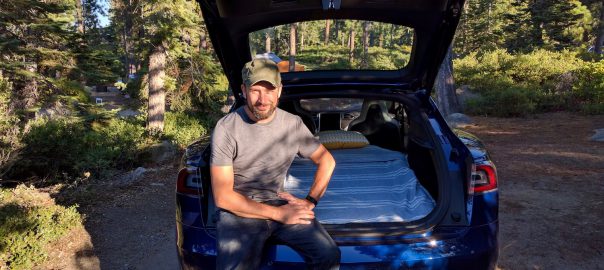Elon Musk inadvertently spawned a subculture that’s hacking the Model S into a 21st century tent.

As the sun set beyond the long-needle pines and emerald waters of Lake Tahoe, I looked across the campfire and laughed out loud. I was about to go “camping” in the back of a $145,000 electric car because, well, it’s become a thing.
Tesla “Camper Mode,” as it’s often called, may not be sanctioned by the company, but a community of drivers is devoted to the practice. There are forums and YouTube videos that praise the virtues of Tesla camping and explore the hacks you’ll need to make it work. There’s even a third-party Tesla car app, with a “Camp Mode” function that will optimize the car’s systems for a good night’s sleep. This is a quirky, little Tesla subculture, and of course I had to try it myself.
I know what you’re thinking (because it was my first thought, too): Why would someone who can afford a Tesla need to bed down inside one? The last time I slept in a car was on a college road trip from Iowa to Florida, and it was a night of eternal torment, with cramped seats, suffocating heat, and mosquitoes that swarmed when we cracked the windows. Who would choose that again?
But Tesla camping promised something different. The sapphire blue Model S I was driving for the week has a 90 kilowatt hour battery—the largest you can find in a car on the road today. In theory, it should be able to handle a night of climate control and HEPA-level air filtration without much limiting of the vehicle’s range. Also, electric cars are virtually silent and release no tailpipe emissions (they don’t have tailpipes) so they won’t suffocate the camper or disturb the local fauna. As for the Model S’s panoramic glass roof, well, no tent can compete with that.
Read more: Bloomberg
